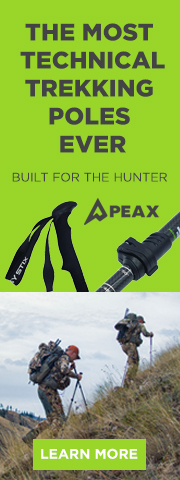With less than a month remaining until most elk seasons start, I thought it might be helpful to have a discussion on what I feel is one of the most commonly used and poorly explained and understood terms in elk hunting: being aggressive.
If I had to define aggressive hunting in a sentence it would be: Actively trying to get a shot. The opposite would be passively hunting which I would define as: Letting the shot happen own its own without influencing the outcome.
I will give a few examples that will hopefully illustrate my point.
Passive hunting:
-Sitting over a water hole or well used trail. You are letting the animal move naturally doing nothing to alter its movement. If one comes by you may get a shot. If one doesn\'t come by, you won\'t.
I tend to think of myself as a pretty aggressive hunter and a few examples come to mind with varying degrees of aggressiveness.
Not aggressive enough:
My first year hunting elk, my hunting partner and I were glassing in the afternoon and saw some elk up high right at timber line. I made a beeline and found a really high wallow near where the elk were feeding. The elk I wanted was the 300ish herd bull. About 15 minutes after setting up I could hear the herd coming. It sounded like a herd of cattle. I had the wallow in a small strip of grass in front of me. A strip of timber behind me and another grassy opening on the other side of the strip of trees. What I didn\'t realize was in the grassy opening behind me was a spring. The elk didn\'t go to the wallow as I had hoped, they went right behind me to the spring. I was well hidden, but there were probably 10 cows and the big herd bull. They drank and grazed for probably 20 minutes. Unfortunately, I was facing the wrong direction and every time I tried to turn around, one of the cows would stare me down. I thought I was going to blow out an eye muscle from looking so hard behind me. Eventually they all wandered away.
What I should have done:
I was used to hunting whitetails where when one blows out, they all blow out. Elk seem to want a little more proof before they waste the energy to run away. Especially in a herd, elk don\'t seemed to be bothered so much by just one elk spooking. I should have slowly turned around, the cow probably would have wondered what I was for long enough to get a shot. Even if she did spook all the others were totally relaxed and they probably would have just wondered what her deal is long enough for me to get a shot.
Really Aggressive:
Last year my partner and I were hunting a spot that has always treated us well. We have killed several big bulls within a hundred yards of each other. The pattern goes the same every time. The herd bull and his harem feed all night above tree line. When morning comes the elk come down into the trees, cross a faint ridge and bed in the north facing timber, we catch them as they cross the ridge. The problem is they are not coming straight down the ridge. They go straight down then move at a diagonal over the ridge so you need to be pretty close as they cut across. We got the bull responding to locator calls. We headed up hill as fast as possible until we saw the first of the cows and stopped to wait. Everything was going according to plan. The bull was big and bugling pretty frequently. Then they started to cut over the ridge. We were too low. The bull was going to be about sixty yards away when I saw him. 30 yards out of my range. I had a small cow and a spike feeding closer and closer to me. I thought I was done, I didn\'t know how I was going to get a shot. The spike got to literally four feet from me and had no idea I was there. My buddy was right behind me and started to laugh quietly because he thought the spike was going to walk into me. I began to wonder where I was going to smack the spike to get him to move along. I was afraid if I spooked the spike and the cow, all the elk would blow out of the area. I got a good look at the bull now moving slowly away from me and decided I needed to do something or my chance would slip away. I decided to run after him. I took off at full speed right for him. The timber is very dense and there where probably 20 cows. Most just watched me run. The spike and cow just looked up at me and went back to eating. I ran right into 30 yards of the bull and came to full draw...no shot...too much brush. I moved again when his sight was obscured by brush. This happened four times. There was something they didn\'t like, but they never spooked, they just kept moving at a leisurely pace. Most likely they thought I was a wound up calf making a raucous. That bull got away but only because brush was always in the way.
Another really aggressive example:
Last year also I located a bull that had a RANK bugle. You can\'t always tell the size of a bull by his bugle, but I knew this bull was big. We played the bugle game for a little while. I would blow a locator bugle and he would fire back a very aggressive bugle with grunts every time. After an hour of this I noticed he wasn\'t coming any closer. I was on the south side of a stream, he was on the north side. I would move closer and bugle, he would bugle back and not move. It was getting late and this needed to happen soon or it wouldn\'t happen. Again, it was very dense timber. Visibility was rarely more than 30 yards. I got to within about 100 yards and ran after him blowing the nastiest bugles I could. He would bugle back and move slowly away. I would get closer and closer. Finally we were within 30 yards of each other but we could rarely see each other. Usually I would see the tip of an antler. I had seen him the day before and knew he was bigger than 320\". I would charge after him blowing a bugle like I wanted to fight or run him out of there. He would just move away and bugle back. Finally after about 30 minutes of being within 30 yards and bugling back and forth he stepped into an opening and stopped to take a look at me. It looked like a thirty yard broadside chip shot. I sent an arrow on the way and it hit him high. I think there was a deflection and of course they never seem to deflect to a better spot. I never found the bull but that is a different story. I am reasonably sure I hit a spinal fin and hopefully didn\'t have a lethal hit. I looked for him for a week and didn\'t find him. Anyway, being aggressive got me the shot.
A few thoughts about being aggressive:
You need to know what you can get away with and that will take some experience. In the examples I gave the wind was always good and the visibility was poor so I took the elk\'s two best defenses out of the equation. When conditions are right you can get away with ALOT. Do not try to force the shot when it isn\'t going to happen. For every time I have been aggressive, there are probably ten or more that I have just left a bugling bull alone because I was sure it wasn\'t going to work out. One thing I would really like to stress is: REPEATEDLY BUMPING ELK IS NOT BEING AGGRESSIVE. IT IS HUNTING POORLY!!!!!!!! Every time you bump elk. Stop and ask yourself what you did wrong and if you had done something different could you have gotten a shot.
That\'s all I\'ve got. Sorry to be so long winded. Let\'s hear some other definitions, examples, thoughts or questions.
If I had to define aggressive hunting in a sentence it would be: Actively trying to get a shot. The opposite would be passively hunting which I would define as: Letting the shot happen own its own without influencing the outcome.
I will give a few examples that will hopefully illustrate my point.
Passive hunting:
-Sitting over a water hole or well used trail. You are letting the animal move naturally doing nothing to alter its movement. If one comes by you may get a shot. If one doesn\'t come by, you won\'t.
I tend to think of myself as a pretty aggressive hunter and a few examples come to mind with varying degrees of aggressiveness.
Not aggressive enough:
My first year hunting elk, my hunting partner and I were glassing in the afternoon and saw some elk up high right at timber line. I made a beeline and found a really high wallow near where the elk were feeding. The elk I wanted was the 300ish herd bull. About 15 minutes after setting up I could hear the herd coming. It sounded like a herd of cattle. I had the wallow in a small strip of grass in front of me. A strip of timber behind me and another grassy opening on the other side of the strip of trees. What I didn\'t realize was in the grassy opening behind me was a spring. The elk didn\'t go to the wallow as I had hoped, they went right behind me to the spring. I was well hidden, but there were probably 10 cows and the big herd bull. They drank and grazed for probably 20 minutes. Unfortunately, I was facing the wrong direction and every time I tried to turn around, one of the cows would stare me down. I thought I was going to blow out an eye muscle from looking so hard behind me. Eventually they all wandered away.
What I should have done:
I was used to hunting whitetails where when one blows out, they all blow out. Elk seem to want a little more proof before they waste the energy to run away. Especially in a herd, elk don\'t seemed to be bothered so much by just one elk spooking. I should have slowly turned around, the cow probably would have wondered what I was for long enough to get a shot. Even if she did spook all the others were totally relaxed and they probably would have just wondered what her deal is long enough for me to get a shot.
Really Aggressive:
Last year my partner and I were hunting a spot that has always treated us well. We have killed several big bulls within a hundred yards of each other. The pattern goes the same every time. The herd bull and his harem feed all night above tree line. When morning comes the elk come down into the trees, cross a faint ridge and bed in the north facing timber, we catch them as they cross the ridge. The problem is they are not coming straight down the ridge. They go straight down then move at a diagonal over the ridge so you need to be pretty close as they cut across. We got the bull responding to locator calls. We headed up hill as fast as possible until we saw the first of the cows and stopped to wait. Everything was going according to plan. The bull was big and bugling pretty frequently. Then they started to cut over the ridge. We were too low. The bull was going to be about sixty yards away when I saw him. 30 yards out of my range. I had a small cow and a spike feeding closer and closer to me. I thought I was done, I didn\'t know how I was going to get a shot. The spike got to literally four feet from me and had no idea I was there. My buddy was right behind me and started to laugh quietly because he thought the spike was going to walk into me. I began to wonder where I was going to smack the spike to get him to move along. I was afraid if I spooked the spike and the cow, all the elk would blow out of the area. I got a good look at the bull now moving slowly away from me and decided I needed to do something or my chance would slip away. I decided to run after him. I took off at full speed right for him. The timber is very dense and there where probably 20 cows. Most just watched me run. The spike and cow just looked up at me and went back to eating. I ran right into 30 yards of the bull and came to full draw...no shot...too much brush. I moved again when his sight was obscured by brush. This happened four times. There was something they didn\'t like, but they never spooked, they just kept moving at a leisurely pace. Most likely they thought I was a wound up calf making a raucous. That bull got away but only because brush was always in the way.
Another really aggressive example:
Last year also I located a bull that had a RANK bugle. You can\'t always tell the size of a bull by his bugle, but I knew this bull was big. We played the bugle game for a little while. I would blow a locator bugle and he would fire back a very aggressive bugle with grunts every time. After an hour of this I noticed he wasn\'t coming any closer. I was on the south side of a stream, he was on the north side. I would move closer and bugle, he would bugle back and not move. It was getting late and this needed to happen soon or it wouldn\'t happen. Again, it was very dense timber. Visibility was rarely more than 30 yards. I got to within about 100 yards and ran after him blowing the nastiest bugles I could. He would bugle back and move slowly away. I would get closer and closer. Finally we were within 30 yards of each other but we could rarely see each other. Usually I would see the tip of an antler. I had seen him the day before and knew he was bigger than 320\". I would charge after him blowing a bugle like I wanted to fight or run him out of there. He would just move away and bugle back. Finally after about 30 minutes of being within 30 yards and bugling back and forth he stepped into an opening and stopped to take a look at me. It looked like a thirty yard broadside chip shot. I sent an arrow on the way and it hit him high. I think there was a deflection and of course they never seem to deflect to a better spot. I never found the bull but that is a different story. I am reasonably sure I hit a spinal fin and hopefully didn\'t have a lethal hit. I looked for him for a week and didn\'t find him. Anyway, being aggressive got me the shot.
A few thoughts about being aggressive:
You need to know what you can get away with and that will take some experience. In the examples I gave the wind was always good and the visibility was poor so I took the elk\'s two best defenses out of the equation. When conditions are right you can get away with ALOT. Do not try to force the shot when it isn\'t going to happen. For every time I have been aggressive, there are probably ten or more that I have just left a bugling bull alone because I was sure it wasn\'t going to work out. One thing I would really like to stress is: REPEATEDLY BUMPING ELK IS NOT BEING AGGRESSIVE. IT IS HUNTING POORLY!!!!!!!! Every time you bump elk. Stop and ask yourself what you did wrong and if you had done something different could you have gotten a shot.
That\'s all I\'ve got. Sorry to be so long winded. Let\'s hear some other definitions, examples, thoughts or questions.



